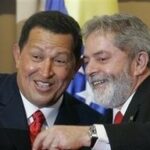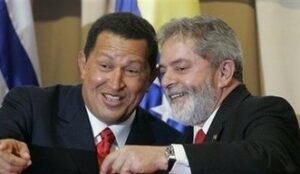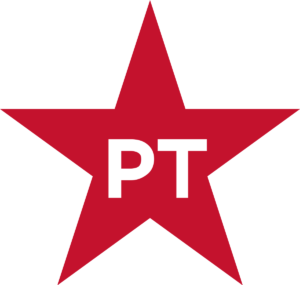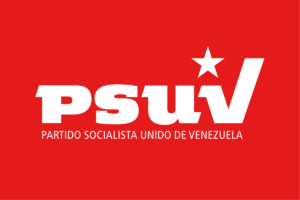DSA’s Flawed International Outlook: The Appeal of the Mass Party and its Contradictions


Hugo Chávez and Lula da Silva
The Democratic Socialists of America has decided that as its international policy, it should principally work to establish political ties to leftist parties that are “mass parties of the working class.” These are parties, like the Workers Party (PT) of Brazil with over 1.5 million members or the United Socialist Party of Venezuela (PSUV) which claims over 7 million members. One can see the attraction: these are parties with not only numbers but also resources, influence, and political power.
The discussion among many in the circles of the DSA International Committee and DSA’s National Political Committee suggests that only such so-called “mass parties” matter, while other organizations don’t merit the group’s attention because they are marginal, insignificant, or described as small sects. The entire emphasis of DSA’s international work is on political parties, with little consideration given to workers’ organizations or social movements.
There’s something very contradictory in this position that needs to be pointed out. The parties that DSA has focused on weren’t always mass parties. Often, they began as just the kind of plebeian networks or far left grouplets that DSA eschews as irrelevant. At the time of their birth, DSA would have ignored them and would have chosen to work with other parties that had a mass working class following. DSA would thus have missed the most important historic developments of the era.
To understand what this means, let’s look back at the history of the Brazilian PT and the Venezuelan PSUV and try to imagine how DSA’s international policy would have worked out in dealing with these parties at their beginnings, that is, had the mass party line been adopted decades ago. Let’s imagine a DSA between the 1970s or 1990s with today’s DSA politics trying to find its way around Latin America at that time.
 The Brazilian Workers Party
The Brazilian Workers Party
The Brazilian Workers Party (PT)—before it became a party—began in the 1970s as a movement among metal workers in the ABC industrial region, a movement of workers striking to improve their conditions and their pay but also challenging the military dictatorship that then ruled the country. There was no party back then, neither a mini- nor a mass party, just a network of working-class activists. Then in 1980, inspired by the Solidarity movement then fighting the Communist Party government of Poland, the network decided to found the PT, a move that attracted a variety of other forces: activists from other labor unions, Christian base communities inspired by the theology of liberation, and some small Trotskyist groups.[1]
What would DSA then–with today’s DSA mass party orientation—have done in Brazil in the late 1970s and the early 1980s as this political effervescence was taking place, presuming that DSA had had a mass-party-of-the-working-class line? DSA would probably have oriented to the Brazilian Communist Party (PCB), which was the historic Marxist-Leninist party and which even in conditions of dictatorship had maintained a mass base. In that period the PCB, not the PT was the historic leftist mass party of the working class. Unwilling to relate to radical networks and smaller parties, DSA would have missed the opportunity to relate to one of the most exciting developments in working class politics at the time.
 Venezuela’s United Socialist Party
Venezuela’s United Socialist Party
Let’s now turn to Venezuela and take a quick look at the history of the left there. Venezuela was the one Latin American country in the late twentieth century with a mass socialist democratic party, Democratic Action (AD). AD worked closely with and had the backing of the Confederation of Venezuelan Workers (CTV) and of most of the country’s intellectuals. And it had figured out a formula to maintain its power and protect its politicians and its policies. AD had entered into a pact with the conservative Catholic Party (COPEI) to keep the two large parties regularly alternating in power. The Communist Party was small and effectively excluded from politics by the pact. That, it seems, would have made DSA’s choice pretty easy. AD was clearly the mass party of the working class.
But other things were happening. In the late 1970s, Hugo Chávez, an officer in the Venezuelan Army created a secret organization within the army called the Liberation Army of the People of Venezuela and then a few years later, he created another such secret organization, the Bolivarian Army 200. Chávez’s eclectic philosophy combined elements of the thought of Simón Bolívar, Ernesto Che Guevara, and other Latin American radicals. In February 1992, he attempted a coup, but it was thwarted. Given a few minutes to call upon the rebels to lay down their arms, he stated on television that he had failed “for now.”
Those words “for now” made him a national hero. When he was released from prison, he was still thinking of overthrowing the government, so he visited Cuba, establishing a relationship with Fidel Castro. Back at home Chávez drew close to the Radical Cause party (Causa R), a small split from the Communist Party with ties to the steelworker’s union. Francisco Arias Cárdenas, a fellow coup plotter and the leader of Causa R, helped Chávez found the Movement for the Fifth Republic (MVR) in 1997 to support Chávez’s campaign for the presidency. There was tremendous optimism and energy surrounding Chávez and great hopes at the beginning that his presidency might open the way for a socialist movement.[2]
If DSA had had the “mass party of the working class” line then, it would most probably have had to choose to work with Democratic Action (AD), the political party that had the loyalty of the country’s labor union leaders and of most of its left intellectuals. AD leader Andrés Pérez was during his presidency (1974-79) a charismatic popular leader friendly with Castro and opposed to the dictatorships of the Southern Cone. One might compare him to Chávez. Causa R, after all, a split from the Communist Party, was a small, marginal group; one might have even called it a Marxist sect.
While Chávez won the election with the help of MVR, even that organization never became the mass party of the working class. Chávez didn’t even establish the PSUV until 2007, giving the current DSA a party to relate to. But what was exciting about Chávez, a military caudillo coming to power, was not the mass party he created from above, but the turbulent, democratic period early in his presidency that encouraged leftists to organize social movements, labor union caucuses, and many small leftist parties. That movement in the early 1990s might have created a mass revolutionary party. In any case, DSA would have missed all of that if it had looked for the mass party of the working class.
Maybe so, you might say, but isn’t it more important that DSA relates to these mass parties today? Well, that raises a number of other questions having to do with these parties and their particular histories, to which we now turn.
Brazil: From Boom to Bust
In Latin America, the Workers Party and the United Socialist Party of Venezuela both came to power in the 1990s in a period of worldwide economic expansion that led to high commodity prices and brought relative prosperity. It was this period of capitalist expansion that made possible the Pink Tide governments in the region.
In Brazil the PT candidate Luiz Inácio “Lula” da Silva, a former steelworker, won the election in 2002, but his party controlled only 18.4 percent of the country’s highly-fragmented and extremely corrupt legislature, requiring it to block with several other political parties, mostly parties on the left, but sometimes also parties on the right. To win the support of those parties Lula found it necessary to regularly deliver bags of cash to some legislators, the famous scandal of the mensalão, the monthly payment.[3]
With that support in the legislature, Lula was thus able to establish a political program based on an alliance between high finance, big construction companies, the labor unions from which he himself had come, and the poor. The cross-class alliance expanded Brazilian capitalism, raised profits, increased taxes, and thus made it possible for Lula to expand social welfare programs, especially for poor women and children. The PT government’s social programs were accompanied by policies that also opened many doors that had been closed to its people of color. Lula’s support grew in the poorer states of Brazil’s northeast and one might say his base shifted from the organized workers movement to the politically weak rural poor.[4]
Everything was going along well for Lula’s program of expanding capitalism and social reforms until the recession of 2008. Suddenly the prices for Brazil’s oil, iron, and soybeans collapsed. Lula’s hand-picked successor, Dilma Rousseff,[5] who took office in 2011, found that, faced with the economic crisis, the management of the country’s capitalist system required austerity, that is, cuts in the social programs that the party had championed.[6] That led to the erosion of support for Rousseff. The Brazilian right now saw its opportunity to drive the PT from power.[7]
Conservative investigative judge Sergio Moro began an extensive corruption investigation, called Lava Jato (Car Wash), that largely focused on Brazil’s Petrobras Oil Company, and which revealed PT officials among others were involved in a variety of crimes, from extorsion and bribery to fraud and malfeasance. (Eventually Lava Jato and another investigation called Zelotes found that virtually every party and many, many of their politicians were also involved in criminal activities.) The PT’s alliance with conservative parties now proved to be disastrous as Rousseff’s rightwing vice-president Michel Temer turned against her. In the end, the right succeeded in removing Rousseff from the presidency in 2016 and imprisoning Lula in 2018. All of this made it possible for Brazil’s far right to take the initiative and elect the reactionary and dangerous Jair Bolsonaro who took office in 2019. After a year in prison, Lula was released and is now preparing to run for president in 2022 and hoping to bring the PT back to power.
While the PT is the country’s largest mass working class party, it is not the only one. As Lula and the Workers Party turned from the idealism and radicalism of its founding period to more authoritarian leadership and conservative policies, some on the party’s left resisted. In 2004 Lula expelled several PT leaders who opposed him. They subsequently formed the Party of Socialism and Liberation (PSOL), committed to the continuing fight for socialism.[8] While not as big as the PT, the PSOL is also mass party, with 200,000 members and nine members in congress.[9] The party has won city council seats and mayoral elections, as well as other positions. PSOL might support Lula in the coming election, though that is still being debated. DSA’s current leadership would like to create an alliance with the PT, despite its conservative policies and its history of corruption, and presumably would not work with PSOL, because it is less of a mass party.
Venezuela’s Crisis
Hugo Chávez served as president from 1999 to 2013, during which time he created the United Socialist Party of Venezuela (PSUV), pressuring the many small left parties to join together in his party, as he similarly took advantage of his initial support among workers and compelled the majority labor organizations to come together in the new labor federation, the National Union of Workers (UNT). The Venezuelan oil industry (PDVSA), by far the country’s most important industry, had already been nationalized back in 1976 by president Carlos Andrés Perez of Democratic Action. In 2002 Chávez’s majority in the National Assembly passed a new hydrocarbon law and entered into a struggle for control of the PDVSA bureaucracy that he eventually won by firing 12,000 employees and putting his own people in charge.
Chávez used the government to direct the country’s economy. He established some new state-owned industries and nationalized other industrial plants, so that by 2004 there were 95 state-owned enterprises producing 30 percent of GDP, though Venezuela remained fundamentally a capitalist country, with the majority of the economic enterprises in private hands. All of the multinational corporations—Chevron, Shell, Total, Repsol, Mitsubishi, General Motors, Nestle, Toyota, Procter & Gamble, Johnson & Johnson, Haliburton, Roche, Maersk, PepsiCo, Coca Cola and McDonald’s— continued to operate in Venezuela, and profited from extraordinary state subsidies through the allocation of foreign currency. On May 5, 2005 Chávez raised the slogan “towards twenty-first century socialism,” but nothing was being done to collectivize the economy as a whole and to put it under the democratic control of the country’s people—which is, after all, the meaning of socialism.
With oil prices high, PDVSA was quite profitable during the early years of Chávez’s presidency and he used that income to finance a variety of social programs. He established the Bolivarian Missions, social institutions and programs to fight poverty, distribute food, improve health, education, and wellbeing in general.[10] In exchange for Venezuelan oil, the Cuban government provided physicians, other health workers, and athletic trainers to help staff these programs. The Missions did a lot of good for many poor people, though they did not change the fundamental structures or property and social classes.
At the same time, the Venezuelan government and PDVSA bureaucracies created new opportunities for individuals to enrich themselves. Those Chavista bureaucrats who grew rich by creating their own companies to work with government firms came to be known as the Bolibourgeoisie. As long as the economy was doing well, just as in a country like Mexico, corruption could be tolerated, but a downturn would lead to intense struggles for the country’s wealth.
The 2008 recession threw the world economy into crisis and brought a fall in prices for Venezuela’s top commodities: petroleum (representing over 70 percent of export earnings), bauxite, aluminum, and steel. Food, clothing, all of the basic necessities in Venezuela became scarce and expensive. The situation was complicated in Venezuela by the death of Chávez in 2013, the charismatic figure who had held the left and everything else together. His successor, Nicolás Maduro, a working-class leftist, faced greater challenges and had less charm and skill than his predecessor. While he turned to China and other countries for assistance, nevertheless Venezuela’s economy continued to collapse.[11]
The rightwing forces that Chávez had repeatedly defeated in national elections, now supported Assemblyperon Juan Guaidó who has claimed since 2019 that he is the “interim president” of the country. He argues that he represents the last democratically-elected institution in Venezuela, the 2015 National Assembly.
As opposition grew both from the business class and the working class, Chavez’s government became more authoritarian. Maduro’s presidential election of 2018 and especially the legislative elections of 2020 are viewed by many as fraudulent. Meanwhile repression grew. As Amnesty International notes, “People expressing criticism of government policies – including political activists, journalists and health workers – were subjected to repressive measures including criminalization, unfair trials and arbitrary detention. There were reports of torture and other ill-treatment and enforced disappearance of those arbitrarily detained.” Out of a nation of 30.1 million, poverty and violence have led 5.5 million Venezuelans to flee the country, most going to Colombia, Ecuador, and Peru.
Today in Venezuela, what DSA would call “the mass party of the working class” is an utterly authoritarian and corrupt organization presiding over a national catastrophe involving both economic collapse and the COVID pandemic. On the other hand, while there is no other mass working class party, there are socialist groups, independent labor union organizations, and social movements that the U.S. left might work with.
The Problem of Left Politics in the Capitalist State
While some of what is discussed in this short article may come as news to some people in the American left, the degeneration of the PT in Brazil or of the PSUV in Venezuela have been widely discussed in those countries by journalists, by sociologists, by political scientists and historians across the political spectrum and by those in the far left as well as by members or former members of the PT and PSUV themselves.
What has happened to the PT in Brazil and the PSUV Venezuela, while both have been particularly dramatic and tragic, is representative of the kinds of problems that leftists have always faced when they work in electoral politics and particularly when they come to power. As leftist parties become involved in bourgeois politics—even when they do so in the striking ways they have in Latin America—they begin to find their place in the state political system, they form alliances with other political parties, they take responsibility for the budget in good times and in bad, they run the army and the police. Once in power, when they attempt to carry out meaningful reforms, they find it extremely difficult to escape the capitalist banks and corporations in their own countries and from the world capitalist economy that controls access to capital and to markets. And they often also face the threat of sanctions from the United States, European countries, and nations in other regions.
We as American radicals have a responsibility to oppose U.S. sanctions, U.S.-inspired coups, and U.S. military interventions. Ultimately, the frustration of socialist projects in Latin America can only be overcome by building regional alliances of socialist parties, so that several nations attempt to create socialist societies more or less at once. (The Foro de São Paulo is not such an international alliance.)[12] Recently left governments in Latin America have sometimes accepted aid from Russia or China because of U.S. sanctions, but those authoritarian capitalist states are also imperial powers with their own agendas and leftists have to be leery of their influence.
There is no doubt that the capitalist world economy’s booms and busts—in particular the 2008 crisis—rocked the nations of Latin America. And the United States government, that is U.S. imperialism, created enormous pressures on the Pink Tide governments, especially in Brazil and Venezuela. Those pressures led political leaders—at first wanting to preserve themselves in power so that they could continue their reform strategies—to become more authoritarian, to restrain and then repress opposition movements of the working class, and to adopt conservative policies of austerity. While we on the left had never supported Lula or Chávez as individuals, we did in the early days offer their governments our critical support, and we enthusiastically backed the labor and social movements that took advantage of the historic opening that the new governments provided. As time went on though, we became more critical of their governments and began to back the dissident currents that arose in the political, labor, and social movements that resisted turns toward authoritarianism and austerity, such as PSOL in Brazil and Marea Socialista in Venezuela. Of course, there are many other labor and social movement and political organizations that DSA could relate to.
We supported the left oppositions in these countries because we believe that it is not the left’s job to justify and apologize for leaders, parties, or governments that may call themselves socialist. Our job is to analyze the governments and parties and to support the struggles of workers, the poor, the indigenous, the people of color, women, and the LGBT communities. As socialists, we look forward to and support the building of genuine mass, democratic, socialist parties, and believe we should orient to their revolutionary currents. The key thing is not that the party is massive, but that it is genuinely fighting for working people and for a socialist transformation of the society.
Notes:
[1] Margaret E. Keck, The Workers Party and the Democratization of Brazil (New Haven: Yale University Press, 1992) describes all of this at great length and in detail. The excitement of the PT in its early days was also caught in such books as: Emir Sader and Ken Silberstein, Without Fear of Being Happy: Lula, the Workers Party, and Brazil (New York: Verso, 1991) amd Media Benjamin and Maisa Mendonça, Benedita da Silva: An Afro-Brazilian Woman’s Story of Politics and Love (Oakland: Food First Books, 1997).
[2] One can see such optimism in Gregory Wilpert, Changing Venezuela by Taking Power: The History and the Policies of the Chávez Government (New York: Verso, 2007).
[3] Perry Anderson, “Lula’s Brazil,” London Review of Books, March 31, 2011, at: https://www.lrb.co.uk/the-paper/v33/n07/perry-anderson/lula-s-brazil
[4] André Singer, Os sentidos do lulismo: Reforma gradual e pacto conservador (São Paulo: Compania das Letras, 2012), the most complete overview of Lula’s political system. See also: Wendy Hunter, The Transformation of the Workers Party of Brazil, 1989-2009 (Cambridge: Cambridge University Press, 2010).
[5] Dan La Botz, “Brazil: Lula, Rousseff, and the Workers Party Establishment in Power,” New Politics, Winter 2015, at: https://newpol.org/issue_post/brazil-lula-rousseff-and-workers-party-establishment-power/
[6] Fernando Rugitsky, “Austerity Reaches Brazil,” Jacobin, August 9, 2015, at: https://www.jacobinmag.com/2015/09/brazil-pt-austerity-dilma-rousseff-petrobas-real/
[7] André Singer, O Lulismo em Crise (São Paolo: Companhia das Letras, 2018), has the most complete discussion.
[8] Dan La Botz, “Brazil’s Party of Socialism and Freedom, PSOL: Another Way of Doing Politics,” New Politics, Nov. 11, 2014, at: https://newpol.org/brazils-party-socialism-and-freedom-psol-another-way-doing-politics/
[9] Conheça a Bancada Federal do PSOL, at: https://psol50.org.br/parlamentares/?__cf_chl_jschl_tk__=pmd_3ce87c1b98d97327eb489e0558575f358ed433a5-1627053557-0-gqNtZGzNAiKjcnBszQii
[10] Dan La Botz, “Snapshots of the Bolivarian Revolution,” Against the Current, Nov.-Dec. 2005, at: https://againstthecurrent.org/atc119/p37/
[11] See: Simón Rodriguez Porras and Miguel Sorans, “Why Did Chavismo Fail? A balance sheet from the left opposition,” (Buenos Aires: Centro de Estudios Humanos y Sociales, 2018) provides a detailed account of the character of the Chávez and Maduro government.
[12] Dan La Botz, Report on the Foro de São Paulo, June 2016, at: https://danlabotz.medium.com/report-on-dsa-participation-in-the-foro-de-sao-paulo-san-salvador-el-salvador-june-22-june-25-a4aee2b13499